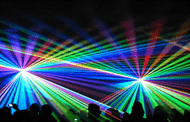Laser Projection – Precision, Power, and Efficiency
Posted by Julio Urbay on 22nd Jun 2025
Cinema has always been a medium driven by light—and in the modern era, laser projection is redefining what that light can do. As theaters move beyond traditional lamps, laser systems are setting a new standard for image quality, operational efficiency, and long-term sustainability.
A New Light Source for a New Era
Unlike xenon or carbon arc lamps, laser projectors use solid-state light sources that generate light through stimulated emission. These systems can be configured in various ways—most notably as RGB laser projectors, which use separate red, green, and blue lasers to produce a full spectrum of color with remarkable accuracy.
The result is a picture that is brighter, sharper, and more color-accurate than anything previously possible. Laser projectors can achieve deeper blacks, higher contrast ratios, and a wider color gamut—often exceeding the DCI-P3 standard and approaching the full BT.2020 color space.
Longevity and Low Maintenance
One of the most significant advantages of laser projection is its lifespan. While xenon lamps typically last between 500 and 2,000 hours, laser light sources can operate for up to 30,000 to 50,000 hours with minimal degradation. This dramatically reduces the need for lamp changes, recalibration, and downtime.
Laser systems also eliminate the need for high-voltage igniters, cooling fans for lamp housings, and the handling of fragile, high-pressure bulbs. The result is a quieter, more reliable projection system that requires less hands-on maintenance and fewer consumables.
Energy Efficiency and Environmental Impact
Laser projectors are more energy-efficient than their predecessors, converting a higher percentage of electrical power into usable light. They also generate less heat, which reduces the load on HVAC systems and contributes to lower overall energy consumption.
From an environmental standpoint, laser systems avoid the use of mercury and other hazardous materials found in traditional lamps. This makes them a cleaner, safer choice for theaters looking to reduce their ecological footprint.
Enhanced Viewer Experience
For audiences, the benefits are immediate and visible. Laser projection delivers consistent brightness across the entire screen, even in large-format auditoriums. It supports high frame rates, 3D content, and high dynamic range (HDR), offering a more immersive and lifelike viewing experience.
Whether it’s the subtle texture of a costume or the shimmer of a distant starfield, laser light brings out details that might otherwise be lost. It’s not just brighter—it’s better.
Adoption Across the Industry
Major cinema chains and boutique theaters alike are embracing laser projection as a long-term investment. From IMAX and Dolby Cinema to independent venues upgrading their auditoriums, the shift reflects a broader industry commitment to quality and sustainability. As installation costs continue to fall and technology becomes more accessible, laser projection is no longer a luxury—it is quickly becoming the new baseline for modern cinematic presentation.
The Future Is Focused
Laser projection is more than a technical upgrade—it’s a transformation in how stories are illuminated on screen. With its unmatched clarity, efficiency, and longevity, it represents the future of cinema, one brilliant frame at a time.

